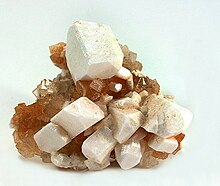| Leonite | |
|---|---|
 Leonite | |
| General | |
| Category | Sulfate mineral |
| Formula (repeating unit) | K2Mg(SO4)2·4H2O |
| IMA symbol | Leo[1] |
| Strunz classification | 7.CC.55 |
| Dana classification | 29.03.03.01 |
| Crystal system | Monoclinic |
| Crystal class | Prismatic (2/m) (same H-M symbol) |
| Space group | C2/m |
| Unit cell | a = 11.78, b = 9.53 c = 9.88 [Å]; β = 95.4°; Z = 4 |
| Identification | |
| Formula mass | 366.69 g/mol |
| Color | White to colorless, yellow |
| Crystal habit | Tabular crystals |
| Twinning | {100} |
| Cleavage | none |
| Fracture | conchoidal |
| Mohs scale hardness | 2.5–3 |
| Luster | Vitreous or waxy |
| Streak | White |
| Diaphaneity | Transparent to translucent |
| Specific gravity | 2.201 |
| Optical properties | Biaxial (+) |
| Refractive index | nα = 1.479 nβ = 1.482 nγ = 1.487 |
| Birefringence | δ = 0.008 |
| 2V angle | Measured: 90° Calc: 76° |
| Dispersion | none |
| Fusibility | easy |
| Other characteristics | Leonit, 钾镁矾, Leonita, Леонит, Kalium-Astrakanit, Kalium-Blödit |
| References | [2][3] |
Leonite is a hydrated double sulfate of magnesium and potassium. It has the formula K2SO4·MgSO4·4H2O. The mineral was named after Leo Strippelmann, who was director of the salt works at Westeregeln in Germany.[4] The mineral is part of the blodite group of hydrated double sulfate minerals.[3]
- ^ Warr, L.N. (2021). "IMA–CNMNC approved mineral symbols". Mineralogical Magazine. 85 (3): 291–320. Bibcode:2021MinM...85..291W. doi:10.1180/mgm.2021.43. S2CID 235729616.
- ^ Mindat.org
- ^ a b Leonite Webmineral data
- ^ "Leonite" (PDF). Mineral Data Publishing. 2005.